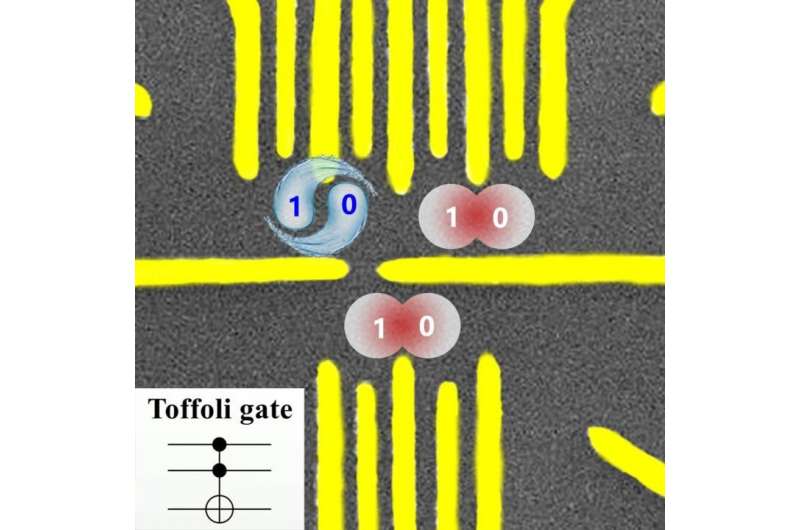Experimentally demonstrated a toffoli gate in a semiconductor three-qubit system

A new progress in the scaling of semiconductor quantum dot-based qubits has been achieved b y researchers at the University of Science and Technology of China. Professor GUO Guoping with his co-workers, XIAO Ming, LI Haiou and CAO Gang, designed and fabricated a quantum processor with six quantum dots, and experimentally demonstrated quantum control of the Toffoli gate. This is the first realization of the Toffoli gate in a semiconductor quantum dot system, which motivates further research on larger scale semiconductor quantum processor. The report, titled "Controlled Quantum Operations of a Semiconductor Three-Qubit System," was published in Physical Review Applied.
The fabrication, manipulation and scaling of semiconductor quantum dot-based qubits are the most important core technologies for scalable semiconductor quantum chips. Professor GUO Guoping's group aims to master these technologies and has been devoted to this area for a long time. Prior to the demonstration of the three-qubit gate, they realized ultrafast universal control of charge qubits based on semiconductor quantum dots in 2013 and achieved the controlled rotation of two charge qubits in 2015.
The Toffoli gate is a three-qubit operation that changed the state of a target qubit conditioned on the state of two control qubits. It can be used for universal reversible classical computation, and also forms a universal set of qubit gates in quantum computation together with a Hadamard gate. Furthermore, it is a key element in quantum error correction schemes. Implementation of the Toffoli gate with only single- and two-qubit operations requires six controlled-NOT gates and 10 single-qubit operations.
As a result, a single-step Toffoli gate can reduce the number of quantum operations dramatically, which can break the limit of coherence time and improve the efficiency of quantum computing. Researchers from Guo's group found the T-shaped six-quantum-dot architecture with openings between control qubits and the target qubit can strengthen the coupling between qubits with different function and minimize it between qubits with the same function. This satisfies the requirements of the Toffoli gate well. Using this architecture with optimized high-frequency pulses, the researchers demonstrated the Toffoli gate in a semiconductor quantum dot system for the first time, which lays a solid foundation for scalable semiconductor quantum processors.
More information: Hai-Ou Li et al, Controlled Quantum Operations of a Semiconductor Three-Qubit System, Physical Review Applied (2018). DOI: 10.1103/PhysRevApplied.9.024015
Provided by University of Science and Technology of China





















